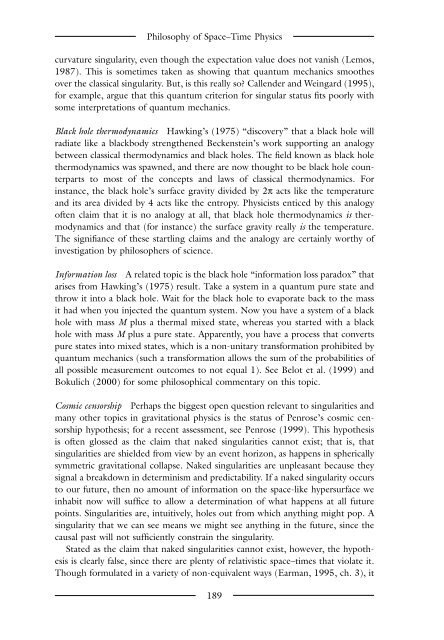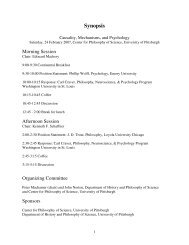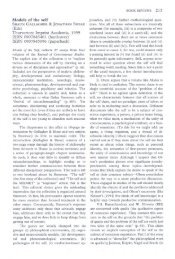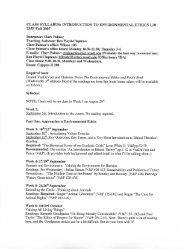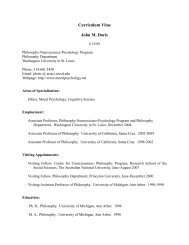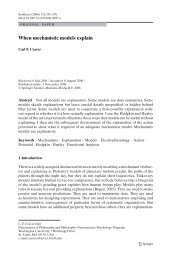The Blackwell Guide to the Philosophy of Science - The Department ...
The Blackwell Guide to the Philosophy of Science - The Department ...
The Blackwell Guide to the Philosophy of Science - The Department ...
Create successful ePaper yourself
Turn your PDF publications into a flip-book with our unique Google optimized e-Paper software.
<strong>Philosophy</strong> <strong>of</strong> Space–Time Physics<br />
curvature singularity, even though <strong>the</strong> expectation value does not vanish (Lemos,<br />
1987). This is sometimes taken as showing that quantum mechanics smoo<strong>the</strong>s<br />
over <strong>the</strong> classical singularity. But, is this really so? Callender and Weingard (1995),<br />
for example, argue that this quantum criterion for singular status fits poorly with<br />
some interpretations <strong>of</strong> quantum mechanics.<br />
Black hole <strong>the</strong>rmodynamics Hawking’s (1975) “discovery” that a black hole will<br />
radiate like a blackbody streng<strong>the</strong>ned Beckenstein’s work supporting an analogy<br />
between classical <strong>the</strong>rmodynamics and black holes. <strong>The</strong> field known as black hole<br />
<strong>the</strong>rmodynamics was spawned, and <strong>the</strong>re are now thought <strong>to</strong> be black hole counterparts<br />
<strong>to</strong> most <strong>of</strong> <strong>the</strong> concepts and laws <strong>of</strong> classical <strong>the</strong>rmodynamics. For<br />
instance, <strong>the</strong> black hole’s surface gravity divided by 2p acts like <strong>the</strong> temperature<br />
and its area divided by 4 acts like <strong>the</strong> entropy. Physicists enticed by this analogy<br />
<strong>of</strong>ten claim that it is no analogy at all, that black hole <strong>the</strong>rmodynamics is <strong>the</strong>rmodynamics<br />
and that (for instance) <strong>the</strong> surface gravity really is <strong>the</strong> temperature.<br />
<strong>The</strong> signifiance <strong>of</strong> <strong>the</strong>se startling claims and <strong>the</strong> analogy are certainly worthy <strong>of</strong><br />
investigation by philosophers <strong>of</strong> science.<br />
Information loss A related <strong>to</strong>pic is <strong>the</strong> black hole “information loss paradox” that<br />
arises from Hawking’s (1975) result. Take a system in a quantum pure state and<br />
throw it in<strong>to</strong> a black hole. Wait for <strong>the</strong> black hole <strong>to</strong> evaporate back <strong>to</strong> <strong>the</strong> mass<br />
it had when you injected <strong>the</strong> quantum system. Now you have a system <strong>of</strong> a black<br />
hole with mass M plus a <strong>the</strong>rmal mixed state, whereas you started with a black<br />
hole with mass M plus a pure state. Apparently, you have a process that converts<br />
pure states in<strong>to</strong> mixed states, which is a non-unitary transformation prohibited by<br />
quantum mechanics (such a transformation allows <strong>the</strong> sum <strong>of</strong> <strong>the</strong> probabilities <strong>of</strong><br />
all possible measurement outcomes <strong>to</strong> not equal 1). See Belot et al. (1999) and<br />
Bokulich (2000) for some philosophical commentary on this <strong>to</strong>pic.<br />
Cosmic censorship Perhaps <strong>the</strong> biggest open question relevant <strong>to</strong> singularities and<br />
many o<strong>the</strong>r <strong>to</strong>pics in gravitational physics is <strong>the</strong> status <strong>of</strong> Penrose’s cosmic censorship<br />
hypo<strong>the</strong>sis; for a recent assessment, see Penrose (1999). This hypo<strong>the</strong>sis<br />
is <strong>of</strong>ten glossed as <strong>the</strong> claim that naked singularities cannot exist; that is, that<br />
singularities are shielded from view by an event horizon, as happens in spherically<br />
symmetric gravitational collapse. Naked singularities are unpleasant because <strong>the</strong>y<br />
signal a breakdown in determinism and predictability. If a naked singularity occurs<br />
<strong>to</strong> our future, <strong>the</strong>n no amount <strong>of</strong> information on <strong>the</strong> space-like hypersurface we<br />
inhabit now will suffice <strong>to</strong> allow a determination <strong>of</strong> what happens at all future<br />
points. Singularities are, intuitively, holes out from which anything might pop. A<br />
singularity that we can see means we might see anything in <strong>the</strong> future, since <strong>the</strong><br />
causal past will not sufficiently constrain <strong>the</strong> singularity.<br />
Stated as <strong>the</strong> claim that naked singularities cannot exist, however, <strong>the</strong> hypo<strong>the</strong>sis<br />
is clearly false, since <strong>the</strong>re are plenty <strong>of</strong> relativistic space–times that violate it.<br />
Though formulated in a variety <strong>of</strong> non-equivalent ways (Earman, 1995, ch. 3), it<br />
189


